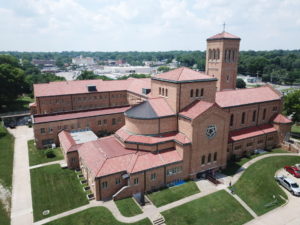 There is a lot of history surrounding this building and its grounds. Located in the Kansas City suburb of Maryland Ridge, the hill on which it stands was the site of some of the fiercest fighting in the Civil War’s second largest battle, the Battle of Westport. A memorial marker in front of the convent commemorates the battle. (see our Summer 2022 Newsletter.)
There is a lot of history surrounding this building and its grounds. Located in the Kansas City suburb of Maryland Ridge, the hill on which it stands was the site of some of the fiercest fighting in the Civil War’s second largest battle, the Battle of Westport. A memorial marker in front of the convent commemorates the battle. (see our Summer 2022 Newsletter.)
At the top of the hill on October 13th, 1945, Bishop Edwin O’Hara, Bishop of Kansas City, turned over the first shovel-full of dirt in the ground-breaking ceremony for a new convent to be occupied by The Benedictine Sisters of Perpetual Adoration. A rough poplar cross was erected on the hill. (Kansas City Times, October 13, 1945.) The purchase of the property by the Sisters involved acquiring multiple parcels, some of which were difficult to obtain.
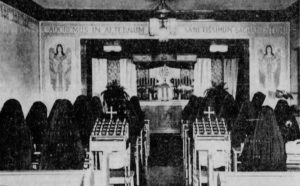 The community of The Benedictine Sisters of Perpetual Adoration was founded in 1875 in Clyde, Missouri, by Benedictine Sisters from Switzerland. Perpetual adoration started at the Clyde Motherhouse in 1878. The Sisters were semi-cloistered and their primary apostolate was perpetual adoration and promotion of devotion to the Holy Eucharist. Among other tasks, they made hosts for the Mass, ran a printing press, and sewed vestments. Bishop O’Hara invited the Sisters to Kansas City in order to have their prayers taking place in the diocese day and night. The Sisters started off in a house on 4408 Rockhill Road on December 5, 1943. By 1945, thirty-five parish groups held adoration there, and with the Sisters’ chapel filled to capacity, they had to build a much larger convent and chapel.
The community of The Benedictine Sisters of Perpetual Adoration was founded in 1875 in Clyde, Missouri, by Benedictine Sisters from Switzerland. Perpetual adoration started at the Clyde Motherhouse in 1878. The Sisters were semi-cloistered and their primary apostolate was perpetual adoration and promotion of devotion to the Holy Eucharist. Among other tasks, they made hosts for the Mass, ran a printing press, and sewed vestments. Bishop O’Hara invited the Sisters to Kansas City in order to have their prayers taking place in the diocese day and night. The Sisters started off in a house on 4408 Rockhill Road on December 5, 1943. By 1945, thirty-five parish groups held adoration there, and with the Sisters’ chapel filled to capacity, they had to build a much larger convent and chapel.
(Photo Kansas City Star June 11, 1946)
“You can’t build like this anymore.”
We have heard that statement made many times as contractors and construction enthusiasts walk through our building. The actual construction started in September of 1947. J.E. Dunn was the builder. Mr. Dunn’s biographer reported that of all of the builder’s many building projects, this was one of his favorites. Below is a view from Meyer Boulevard, looking from the northwest (Kansas City Star, April 11, 1948.) The convent was designed to house 64 Sisters. The Sisters themselves drew a layout of the building and oversaw much of the construction that took place. (read more in these articles: Kansas City Star, 9-12-1948, p 20; Kansas City Star, 6-11-1946 p 64)

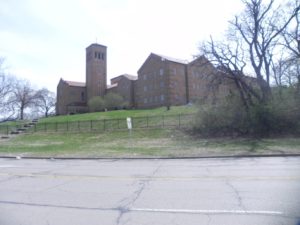
The cornerstone laying ceremony took place on October 3, 1948. Bishop O’Hara and his retinue entered the partially completed chapel, and the Bihsop blessed the place where the altar would soon be installed. Then, before a crowd of 1,500 people, Bishop O’Hara sealed in the cornerstone on October 3rd, 1948, having first placed in it a box containing the history of the order, names of all benefactors, and a copy of Tabernacle and Purgatory, a publication of the Sisters. According to the Kansas City Times of October 4th, 1948, the Bishop “stressed the ceaseless activity of modern man. Man, he said, is wearing himself down, mentally and physically, by rushing continually, ‘without rest, without meditation, without calm.’
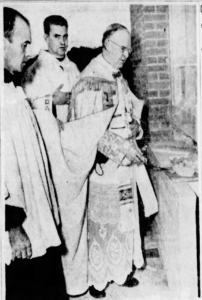 “’The gates of this temple of hope will be open day and night for all men to enter for rest and meditation,’ the bishop said, ‘It will be a retreat from the humdrum of everyday life where men can, through meditation, gain renewed strength and hope.’”
“’The gates of this temple of hope will be open day and night for all men to enter for rest and meditation,’ the bishop said, ‘It will be a retreat from the humdrum of everyday life where men can, through meditation, gain renewed strength and hope.’”
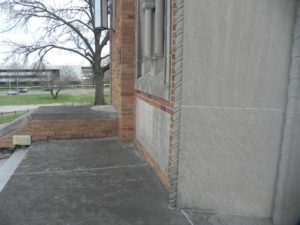
On the April 25th, 1949, workers hoisted four new bells into the bell tower using ropes. The square hole in the floor at the bell tower level (the ceiling of the third floor) can be exposed by uncovering the platform that conceals it. We imagine that the elevator worked, and since it had the capacity to do so, it was probably used to haul each bell to the third floor one or two at a time, depending on the size. Workers could then move the bells in place under the hole, above a back room currently used for storage, and hoist them up beside the bell tower ladder.
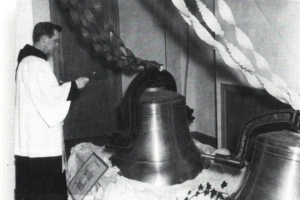
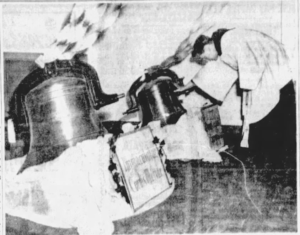
Reverend Father Kevin McGonigle, chaplain for the Sisters, blessed the bells prior to their installation. As is customary, the bells received names. In the left photo are pictured the two largest bells, Holy Ghost and Eucharistic Heart of Jesus. The two smallest bells are Immaculate Heart and John the Evangelist, pictured on the right. The anonymous benefactor named in the article (Kansas City Times, April 25, 1949) was, by multiple accounts given to us, Mr. J.E. Dunn, the builder. About 50 people were present.
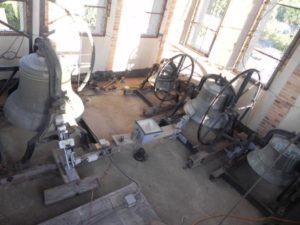 Left to right in this photograph are: Holy Ghost (2100 pounds, E Natural) John the Evangelist (450 pounds, D Natural,) Eucharistic Heart of Jesus (1050 pounds, A Natural,) Immaculate Heart (650 pounds, C Natural.) Originally, there were electronically controlled swingers on a platform above the bells. The swingers would rock the pulley wheels still visible here. When the building was a home for unwed mothers, the bells were rung to announce a new baby. Eventually, the various mechanical elements wore out and the bells fell silent for ten years. In August of 2022 a benefactor paid to make the bells ring again. The expense of swingers was prohibitive, so we had outside strikers installed. The bells toll the Angelus at 12pm and 5pm daily, and we peal them for special occasions.
Left to right in this photograph are: Holy Ghost (2100 pounds, E Natural) John the Evangelist (450 pounds, D Natural,) Eucharistic Heart of Jesus (1050 pounds, A Natural,) Immaculate Heart (650 pounds, C Natural.) Originally, there were electronically controlled swingers on a platform above the bells. The swingers would rock the pulley wheels still visible here. When the building was a home for unwed mothers, the bells were rung to announce a new baby. Eventually, the various mechanical elements wore out and the bells fell silent for ten years. In August of 2022 a benefactor paid to make the bells ring again. The expense of swingers was prohibitive, so we had outside strikers installed. The bells toll the Angelus at 12pm and 5pm daily, and we peal them for special occasions.
On May 15, 1949, the Blessed Sacrament was transferred from the Rockhill convent to the new convent, escorted by hundreds of Knights of Columbus in full regalia. The 100-car procession proceeded down Rockhill road, turned left on 55th St, then right onto Paseo. Adoration began right away, followed by notification to the Sisters on Rockhill road to cease adoration. Thirty-two Sisters moved into the new convent. The dedication of the chapel took place on Tuesday, May 17, followed by a pontifical Mass. Cardinal Stritch of Chicago gave the sermon, and other Bishops and priests were also present, as well as Mr. J.E. Dunn, the builder, who played a key role in the procession. The bells were rung for the first time, and, following the Mass, the Blessed Sacrament was exposed in a 4-foot high monstrance. An elevator behind the altar lifted the priest up to replace the Blessed Sacrament.
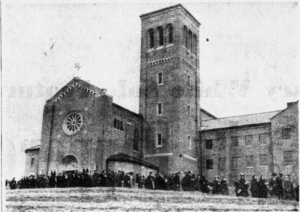 1950 was a Holy Year, and Bishop O’Hara arranged for a pilgrimage to be made each Sunday of this year to gain the Holy Year indulgences. The first of these pilgrimages took place on January 1st. The Benedictine Convent of Perpetual Adoration, St. Augustine’s Church, and the Cathedral of the Immaculate Conception were the three stops on this weekly pilgrimage, and pilgrims prayed the necessary prayers at each stop along the way. About 450 faithful took part in the January 1st pilgrimage.
1950 was a Holy Year, and Bishop O’Hara arranged for a pilgrimage to be made each Sunday of this year to gain the Holy Year indulgences. The first of these pilgrimages took place on January 1st. The Benedictine Convent of Perpetual Adoration, St. Augustine’s Church, and the Cathedral of the Immaculate Conception were the three stops on this weekly pilgrimage, and pilgrims prayed the necessary prayers at each stop along the way. About 450 faithful took part in the January 1st pilgrimage.
Also during the Holy Year of 1950, which was also the centennial year for Kansas City, J.E. Dunn built a replica of one of Kansas City’s first Catholic churches in the front yard of the convent. The original church was built in 1835 by Fr. Benedict Roux, and stood at the location where current day 11th Street and Pennsylvania Avenue intersect.
An annual outdoor Mass and Corpus Christi procession was held at the convent each year, attended by large numbers of faithful, including various organizations such as the Knights of Columbus, wearing their full regalia. For at least one procession, the Bishop Hogan High School band played. (Kansas City Star, May 27, 1956, page 19)
In 1953, the Sisters celebrated 75 years of perpetual adoration that had started in Clyde in 1878.
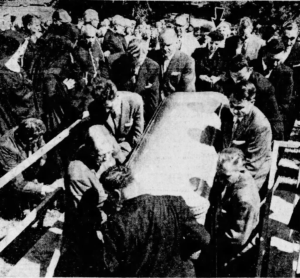
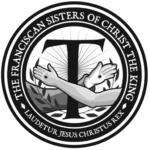


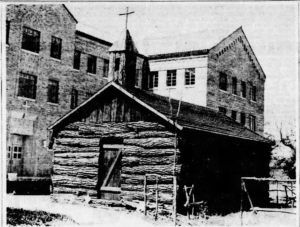
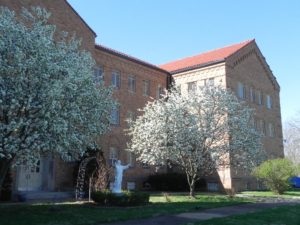
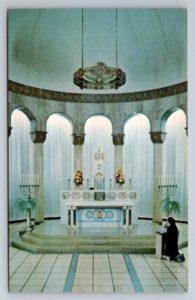 By the early 1980s, however, they had to stop. In the wake of Vatican II, new vocations had dwindled, and the Sisters who had gone to their eternal reward had no replacements. In August of 1983 at a chapter meeting, the decision to sell the convent was made. The two main factors that went into this decision were the advanced age of the remaining Sisters and the “trend toward smaller living groups.” (Kansas City Star, 2 January 1983.) There were 14 Sisters at the convent when it was sold to Youth for Christ in October, 1984. The altar was removed. Archbishop O’Hara’s body was disinterred and buried in nearby Mount Olivet cemetery.
By the early 1980s, however, they had to stop. In the wake of Vatican II, new vocations had dwindled, and the Sisters who had gone to their eternal reward had no replacements. In August of 1983 at a chapter meeting, the decision to sell the convent was made. The two main factors that went into this decision were the advanced age of the remaining Sisters and the “trend toward smaller living groups.” (Kansas City Star, 2 January 1983.) There were 14 Sisters at the convent when it was sold to Youth for Christ in October, 1984. The altar was removed. Archbishop O’Hara’s body was disinterred and buried in nearby Mount Olivet cemetery.